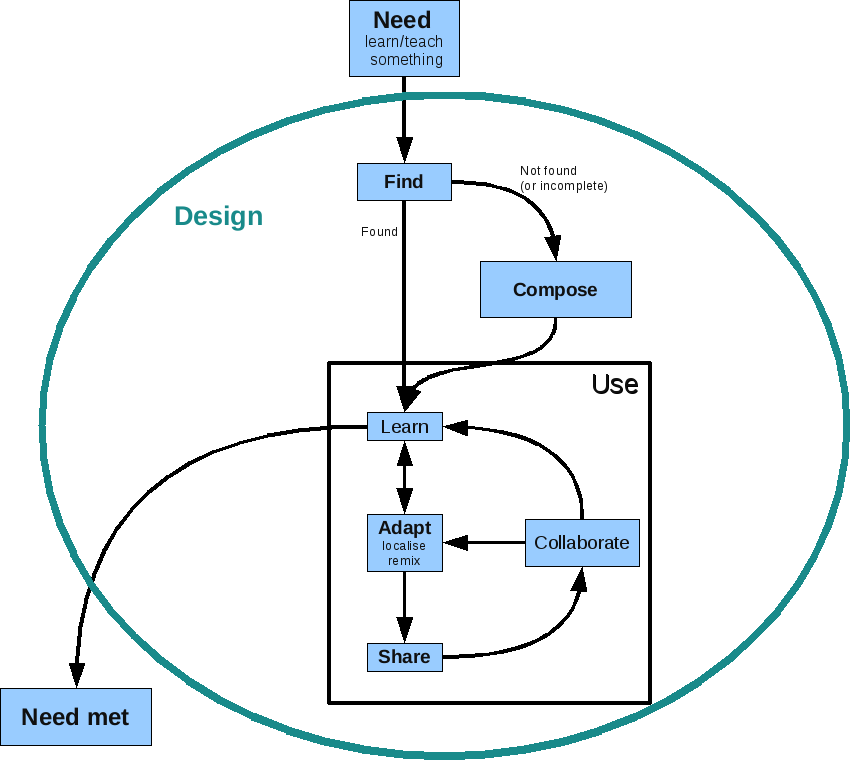OER Cycle (straw dog)
| OER Handbook for educators | |
|---|---|
| Introduction | Defining OER | Why OER? | The Copyright Paradox | Considerations | Models and Approaches | OER Life Cycle |
This handbook is organized around the OER lifecycle. Each section will guide you through the individual parts of OER production and use. The sections will make the most sense when read in order, although it is not required. Feel free to refer to any other part of the handbook at any time.
- See also: discussion.
OER Usage Scenarios
Or: "OER Development Cycle" or "OER Life Cycle" or ...
Figure X (above) illustrates a generic process for OER design and use.
- Need: It all starts with a need to learn or teach something.
- Find: The first proactive step is to search for exisitng OER which either meet the need, or play some role in meeting the need. Finding OER may include
- sifting through learning resources previously used in your department (lecture notes, class projects, handouts, solution sets, etc.),
- using general search engines such as Scroogle, Creative Commons Search, etc.
- the search facilities of particular OER repositories, and/or
- browsing individual websites concerned with the topic of interest.
- Build: Make the OER yourself, preferably using open source tools, possibly with a little help from colleagues and students.
- Use/Learn: Ultimately, the resource will be available for use by learners and/or educators. Usage scenarios typically resemble a continuation of the life-cycle and the resource is incrementally improved in this process. For this reason, OER are often shared early in the cycle towards learner-centred design.
- Adapt: Adapt the resource to suit your learning/teaching style and learners including
- Localise: translate and recontextualise the materials for the learners,
- Synthesise: where several OER have been collected, bring them together and compose a cohesive learning resource designed to effect or facilitate the required learning.
- This step is also known as Remixing resources, one of the most enjoyable parts of OER production and learning with these resources.
- Enhance: improve the resources by filling in any gaps, adding/removing material, and making any necessary corrections (from spelling mistakes to conceptual flaws).
- Share: Finally, the resource is ready for sharing with learners and/or educators. The resource may be shared internally, within your organisation (e.g.) by e-mail, on CD/DVD, or on an intranet site, or made public (e.g. by publishing it on an OER site such as WikiEducator or Connexions).
We offer a few illustrative usage scenarios in this handbook.
This lifecycle applies to an individual OER as well as large OER projects. OER take a variety of forms. Some are highly contextualised and need to be embedded in very specific points of broader learning programmes. Others are less context-specific and may be used for multiple purposes. The degree to which they fit this cycle and benefit from the iterative use-improve cycle also varies. Although the lifecycle follows a logical progression, it is not necessarily followed sequentially. Some parts, such as localize and synthesise, can be done simultaneously with other parts or out of order.
Legalities
One issue which permeates all steps of this process is licensing of resources. Currently (in most countries), unless otherwise stated, all rights are reserved for the authors of any resource represented on any medium until copyright expires. Permission is required to use, adapt, enhance or share the resource. Section XYZ covers all aspects of licensing and explains how the approaches associated with OER work around the barriers.
See Also
Sources
Wiley, D. (2008, January). Personal Communication (with Seth on previous representations before this "straw dog").
Tucker, K.C. (2008) - after David Wiley.
